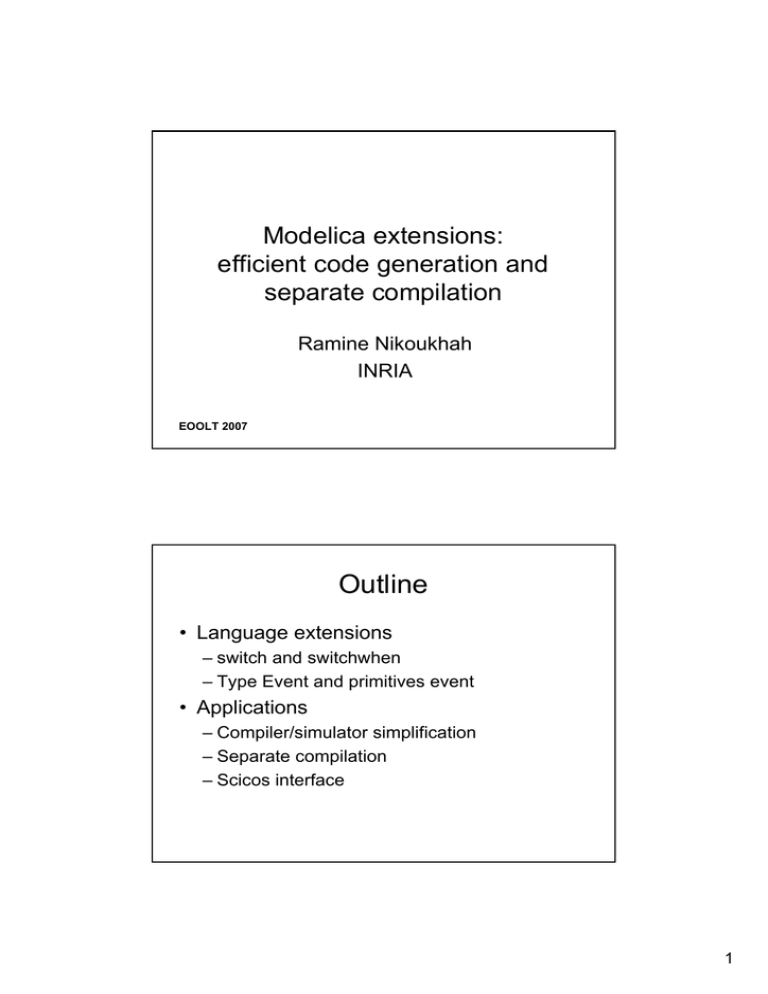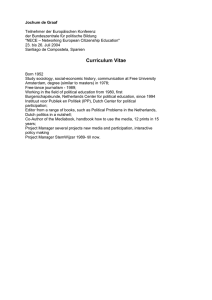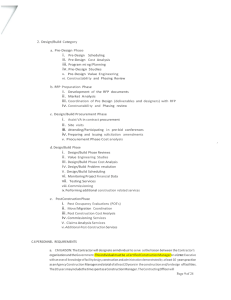Outline Modelica extensions: efficient code generation and separate compilation
advertisement

Modelica extensions:
efficient code generation and
separate compilation
Ramine Nikoukhah
INRIA
EOOLT 2007
Outline
• Language extensions
– switch and switchwhen
– Type Event and primitives event
• Applications
– Compiler/simulator simplification
– Separate compilation
– Scicos interface
1
Language extensions
switch and switchwhen
• switch generalizes constructor if-then-else.
switch (n)
case 1 :
< eq1 >
< eq2 >
…..
case 2 :
< eq3 >
< eq4 >
…..
case default:
< eq5 >
< eq6 >
…..
end switch;
One and only one case is active
depending on the value of n.
Counterpart in Scicos is realized
with ESelect block
May accept missing cases with warning
(similar to conditions on branches of if)
• switchwhen generalizes constructor when-elsewhen.
• In most cases, simultaneous detection of
time events (e.g. zero-crossings) needs not
be considered as a special case.
• By default, time events are considered
asynchronous, in case of “accidental”
simultaneous detection, one event is
activated after another (no specified order).
For special cases, the switchwhen
constructor allows to take advantage of this
additional information if needed.
• Very useful in some applications
• Essential for module isolation
switchwhen {c1,c2,c3}
case ‘001’ :
< eq1 >
< eq2 >
…..
case ‘010’ :
< eq3 >
< eq4 >
…..
Case ‘111’:
< eq5 >
< eq6 >
…..
end switchwhen;
For example if events c1 and c3 are simultaneously
detected, then case ‘101’ is activated.
2
Example of usage of switchwhen:
Consider contact between three balls:
Ignoring the possibility of simultaneous contact:
equation
der(x1)=v1;der(x2)=v2;der(x3)=v3;
der(v1)=0;der(v2)=0;der(v3)=0;
when x1-x3<=1 then
reinit(v1,pre(v3));
reinit(v3,pre(v1));
end when;
when x2-x3<=1 then
reinit(v2,pre(v3));
reinit(v3,pre(v2));
end when;
}
Wrong simulation result in case of
simultaneous contact
Solution to fix the wrong
simulation result
when x1-x3<=1 then
if v1>v3 then
reinit(v1,pre(v3));
reinit(v3,pre(v1));
end if;
end when;
when x2-x3<=1 then
if v2>v3 then
reinit(v2,pre(v3));
reinit(v3,pre(v2));
end if;
end when;
Not a flexible solution: does not
allow to explicitly specify what
happens in case of simultaneous
contact
Using switchwhen, the dynamics of simultaneous
contact can be explicitly expressed
equation
der(x1)=v1;der(x2)=v2;der(x3)=v3;
der(v1)=0;der(v2)=0;der(v3)=0;
switchwhen {x1-x3<=1,x2-x3<=1} then
case "10":
reinit(v1,pre(v3));
reinit(v3,pre(v1));
case “01":
reinit(v2,pre(v3));
reinit(v3,pre(v2));
case "11":
<TO DO IN CASE OF
SIMULATANEOUS CONTACT>
end switchwhen;
Consider explicitly every case
3
Type Event and primitive event
Currently events coded by Booleans:
equation
e=edge(time>2) ;
e=sample(0,1) ;
Not normal Booleans: impulsive type
when k>0 then
c=edge(b) ;
edge does not always
produce impulsive Boolean
No distinction between
Boolean and event
Coding events as Boolean creates confusion
discrete Real d,k;
Boolean b,c;
equation
when sample(0,.1) then
if c then
k=pre(k)+1;
else
k=pre(k);
end if;
end when;
when sample(.22,.3) then
b=d>0;
c=edge(b);
d=pre(d)+1;
end when;
k is incremented three times
during a single edge(b)
4
Type Event codes the time of events as float
Event e1(start=0),e2 ;
equation
when e1 then
e2=e1+1 ;
e2 is an event delayed by one
Delay can be used to emulate sample(0,1):
Event e(start=0) ;
equation
when pre(e) then
e=pre(e)+1 ;
end when ;
Operation on
Events
Primitive event
Primitive event resembles edge:
• But it generates Event not Boolean.
Event e1,e2;
……
equation
der(x)=sin(x);
e1=event(x>.2) ;
when e1 then
d=pre(d)+1 ;
e2=event(d>4) ;
…..
Zero-crossing event detected by
numerical solver (asynchronous)
synchronous with e1
5
Argument of when must be an Event
equation
der(x1)=v1;der(x2)=v2;der(x3)=v3;
der(v1)=0;der(v2)=0;der(v3)=0;
E1= event(x1-x3<=1);
E2=event(x2-x3<=1);
switchwhen {E1,E2} then
case "10":
reinit(v1,v3);
reinit(v3,v1);
case “01":
reinit(v2,v3);
reinit(v3,v2);
case "11":
<TO DO IN CASE OF
SIMULATANEOUS CONTACT>
end switchwhen;
Generate events.
Not allow:
B1=(x1-x3<=1);
Only Event types can be
argument of when and
switchwhen
Applications
Compiler/simulator simplification:
Manipulating Events explicitly simplifies model construction:
No need to use artificial tests against time.
Example: Modeling the propagation delay in a digital circuit requires a
variable dependent event delay:
when time>c_time then
d_time=c_time+u;
end when;
when time>d_time then
…..
using Event types
when c_time then
d_time=c_time+u;
end when;
when d_time then
…..
It also simplifies the compiler: compiler no longer needs
to “figure out” what “tests” are simple enough to be
implemented without solver zero-crossing mechanism.
6
Canonical representation of flat model
and compiled model
Using exclusively Events to condition when clauses, structures the model.
Event e1,e2,e3,…;
…….
equation
……
e1=event(…
when initial then
….
end when;
when e1 then
k=pre(k)+1;
e2=event(k>1);
….
when e2 then
e3=time+1;
….
end when;
…..
After compiler phase I
All secondary
when’s removed
e2 is removed: only
asynchronous events
remain
Event e1,e3,…;
…….
equation
when continuous then
e1=event(…
….
end when;
when initial then
….
end when;
when e1 then
k=pre(k)+1;
if (k>1) and not(pre(k)>1) then
e3=time+1;
….
end when;
…..
At the end of phase I, only asynchronous Events
remain.
• Asynchronous events, explicitly declared as Event, are of
two types:
– Zero-crossing: implemented using zero-crossing mechanism of
the numerical solver
– Predictable: e.g., e2=e1+1;
• The type of Event is coded in the model by user, not
guessed by the compiler (may consider allowing compiler
to switch type from zero-crossing to predictable when
possible)
• Compiler Phase II performs static scheduling
independently for the codes associated with each Event,
and for sections: “continuous”, “initial” and “terminal”.
• Simulator interacts with the code through Events. It uses
an “Event Scheduler” on run-time.
7
Separate compilation
Module isolation can be realized using input/output Events. Example:
Option: extend definition of function
function event_delay
input Event e1;
output Event e2;
input Real u;
equation
when e1 then
e2=e1+u;
end when;
end event_delay;
model SlowDownCounter
event_delay BB;
Event E(start=0);
discrete Real U(start=1);
discrete Integer k(start=1);
equation
when pre(E) then
k=pre(k)+1;
(E)=BB(pre(E),U);
end when;
end SlowDownCounter
In this case SlowDownCounter can be compiled without knowledge of the
content of event_delay function.
This function can be compiled separately too or written in C (for example a
Scicos block routine).
May use block instead of function, and declare it external in SlowDownCounter
Isolated modules can be a lot more general
than external functions; they can have:
•
•
•
•
Input/output Events
Internal states: der() and pre()
Conditioning: if-then-else and switch
Sub-sampling under isolation condition:
All Events within the module must either
come from input or be asynchronous
This condition guarantees that the calling environment
knows when to call the external module. Specifically it
avoids nested when clauses which are meaningless.
8
Some information concerning module must be
provided:
• What inputs affect outputs directly (direct feed through)
• Is block always active (contains continuous variables)
• If the module contains der(), the continuous state and its
derivative must be input and output.
These conditions are exactly the block properties
provided to the compiler in Scicos. They are enough
for compilation and code generation.
The internal function of the block is not known by
the compiler; the code is in general provided as a
dll. The associated “black box” routines are called
during simulation.
Isolated Modelica module
Event inputs
regular
outputs
regular
inputs
Can be an external block:
• Scicos block
• Simulink block (under
certain conditions)
Event outputs
• Output events are not synchronous with input events
• switchwhen sometimes needed inside the block (event inputs can
be synchronous, or not)
• Under certain conditions, connected blocks can become a block:
Similar to
Super Block in Scicos
9
Scicos Interface
• Scicos block can be used in a Modelica model
• Modelica Isolated Module can be used as
Scicos block (Simpa Project)
Scicos block interface
#include "scicos_block.h"
#include <math.h>
void my_block(scicos_block *block,int flag)
{
...
}
flag
job
0
Compute state derivative
1
Compute outputs
2
Update states
3
Output event dates
4
Initialization
5
ending
9
Compute zero crossings and
modes
10



